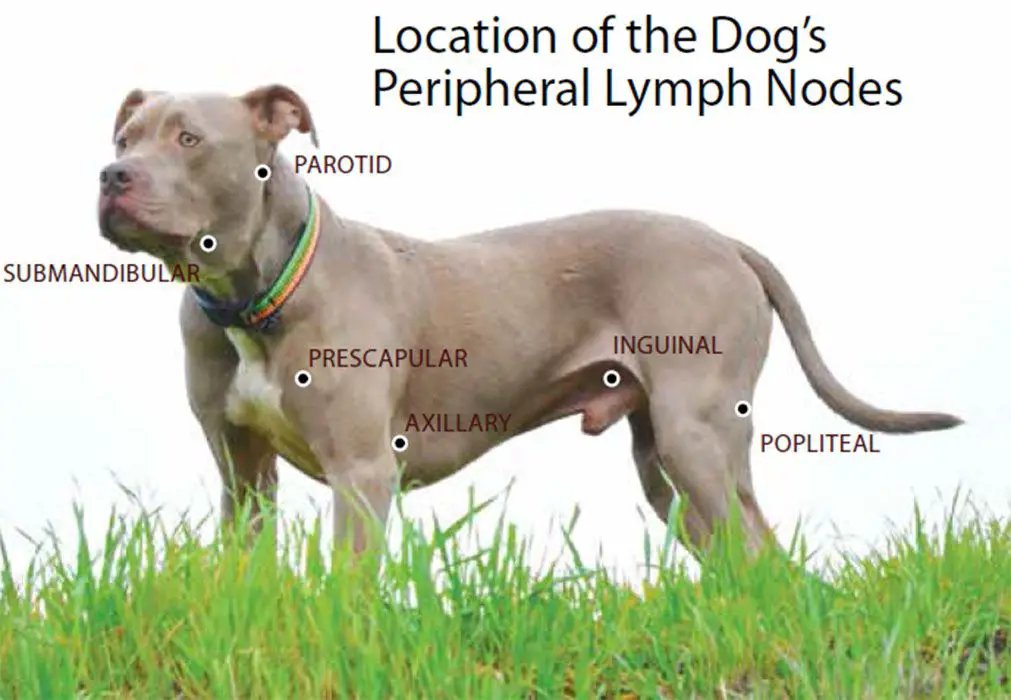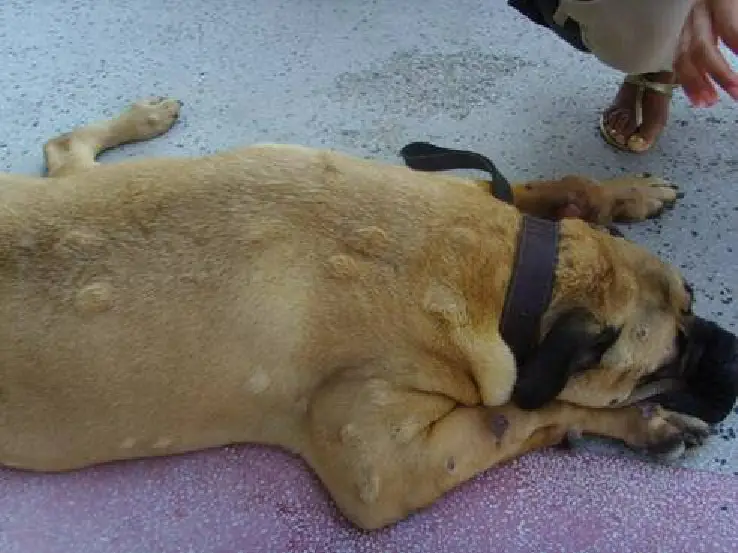What is dog lymphoma and what are the symptoms?
Dog Lymphoma is a type of cancer that affects the lymphocytes, a type of white blood cell. The most common symptoms of dog lymphoma include:
– Enlarged lymph nodes
– Weight loss
– Lethargy
– Loss of appetite
– Difficulty breathing
– vomiting
– Diarrhea
– Persistent cough
If your dog exhibits any of these symptoms, it’s important to bring them to the vet as soon as possible for an examination. Diagnosing and treating dog lymphoma early is critical for the best possible outcome.

How many Lymphomas exist?
At least 30 varieties of canine lymphomas exist, categorised into four types. These include:
– Alimentary lymphoma: This is the most common type of canine lymphoma, and it originates in the gastrointestinal tract.
– Multicentric lymphoma: This type of lymphoma affects multiple lymph nodes throughout the body.
– Extranodal marginal zone B-cell lymphoma: This rare type of lymphoma starts in the eye, skin or central nervous system.
T-cell lymphoma is the least common type of canine lymphoma, and it typically affects older dogs.
What are the causes of dog lymphoma?
There is no one cause of dog lymphoma, but certain risk factors have been identified. These include:
– Breed: Certain breeds are more susceptible to developing lymphoma than others. Breeds at increased risk include Boxers, Golden Retrievers, Bullmastiffs, Scottish Terriers, Boston Terriers and Basset Hounds.
– Age: Dogs of all ages can develop lymphoma, but it is most commonly diagnosed in dogs between the ages of 6 and 14.
– Gender: Male dogs are slightly more likely to develop lymphoma than female dogs.
– Environment: Dogs exposed to certain chemicals or pesticides may be at an increased risk of developing lymphoma.
– Immune system: Dogs with a compromised immune system are more susceptible to developing lymphoma.

How can you find out your dog has lymphoma?
There is no one definitive test for diagnosing dog lymphoma. The vet will likely start with a physical examination and a review of your dog’s medical history. They may also recommend one or more of the following tests:
– Complete blood count (CBC): This test looks for abnormal white blood cell levels, which can indicate lymphoma.
– Chemistry panel: This test measures the levels of various enzymes and proteins in the blood. Abnormalities can suggest the presence of cancer.
– X-ray: An x-ray can help the vet to identify any enlarged lymph nodes or other abnormalities.
– Ultrasound: An ultrasound can provide detailed images of the internal organs and help identify any abnormal growths.
– Biopsy: A biopsy is the only definitive way to diagnose lymphoma. A small tissue sample is taken from an affected lymph node and examined under a microscope.
You may like: why does my dog scratch my bed sheets?
When is the best time to euthanize your dog with lymphoma?
A pet owner needs to ask the question, “When is the best time?” Before you decide to put down a lymphoma dog, consult your veterinarian. Sometimes, your veterinarian might be able to determine the right time to put your dog down for lymphoma. However, you might have to decide based on your dog’s behavior and health condition in other cases. Let’s first learn more about the dog euthanasia process and lymphoma cancer.
If your dog has appetite issues, it can be a sign of lymphoma.
Dogs with lymphoma can have a difficult time eating when they are sick. Sometimes, a dog with lymphoma may refuse to eat. This behavior should be reported to your veterinarian immediately. There are cases when cancer has spread to the lymph nodes and throughout the body. Dogs with lymphoma may lose their appetite and have a reduced ability to perform many tasks.

What are the treatment options for dog lymphoma?
The treatment options for dog lymphoma will vary depending on the type, stage and location of cancer. The most common treatment options include:
– Chemotherapy: This is the most common treatment option for dogs with lymphoma. Various chemotherapy drugs are available and can be given intravenously or orally.
– Radiation therapy: This treatment uses high-energy beams to kill cancer cells. It is typically used in combination with chemotherapy.
– Surgery: In some cases, surgery may be recommended to remove tumours or enlarged lymph nodes.
– Steroids: Steroids can help to reduce inflammation and shrink tumours. They are often used in combination with other treatments.
What is the prognosis for dogs with lymphoma?
The prognosis for dogs with lymphoma depends on factors, including cancer type, stage and location. Early diagnosis and treatment offer the best chance for a positive outcome. The average survival time for dogs with lymphoma is 6 to 12 months. However, some dogs may live for 2 years or more with treatment.
You may like: how to treat dog ear infection without vet?
Dog cancer treatment.
There are many treatment options available for dogs suffering from cancer. This depends on whether or not the cancer is incurable. When cancer has spread to other parts of the body, such as the liver, lungs, and bones, treatment options like surgery, chemotherapy, and radiation, work best. Chemotherapy’s side effects include difficulty breathing, vomiting, hair loss, and hair loss.

What is the best time to give chemotherapy to a lymphoma dog?
When your vet orders chemotherapy in a lymphoma dog, there are many things to think about. Firstly it’s whether the treatment will kill the cancer cells. Secondly is whether chemotherapy can prevent or slow down the progression of cancer cells and, the final question is whether chemotherapy can stimulate healthy cells to attack the cancer cells. As a result, A lung biopsy will be performed on most dogs suffering from chronic lymphocytic carcinoma. Moreover, this is to determine if it has spread to their lungs. Your vet may recommend euthanasia if none of these options work.
You may like: Red husky
What happens when lymphoma progresses to bone marrow?
A dog with lymphoma in his bone marrow requires very aggressive treatment because cancer has already reached an advanced stage. The bone marrow treatment is usually started after cancer has spread or after a first response has been observed in the lymph nodes. Because, sometimes, chemotherapy and radiation are combined with bone marrow therapy. Bone-marrow transplantation may be another option. This treatment involves removing a small amount of bone marrow from a dog. This treatment can be used in conjunction with bone marrow transplantation, a more effective way to treat lymphomas. However, it has a higher chance of failure and should only be considered an option.

What are the stages of lymphoma cancer in dogs?
- Your pet might experience mild to moderate clinical signs of lethargy during the initial stages of lymphoma, but, If your pet is diagnosed with lymphoma, it may not show any signs or display minimal arousal.
- The second stage of lymphoma is characterized by increased body temperature, decreased appetite, decreased total lymph nodes, and difficulty breathing.
You may like: Why Does My dog walk in a circle And panting?
When should you euthanize your pet, finally?
When to kill a pet with euthanasia is a difficult decision for a pet parent, because it depends on the type of cancer, the stage the cancer is in, and the pain your dog suffers, Dogs with cancer should be monitored closely, and it is best to prepare the home environment for a cure while it is still early so that the dog can enjoy a long, healthy life.

Conclusion
When to kill dogs with euthanasia depends on the type of cancer, the stage the cancer is in, and the pain your dog suffers. But, dogs with cancer should be monitored closely, and it is best to prepare the home environment for a cure while it is still early so that the dog can enjoy a long, healthy life.





